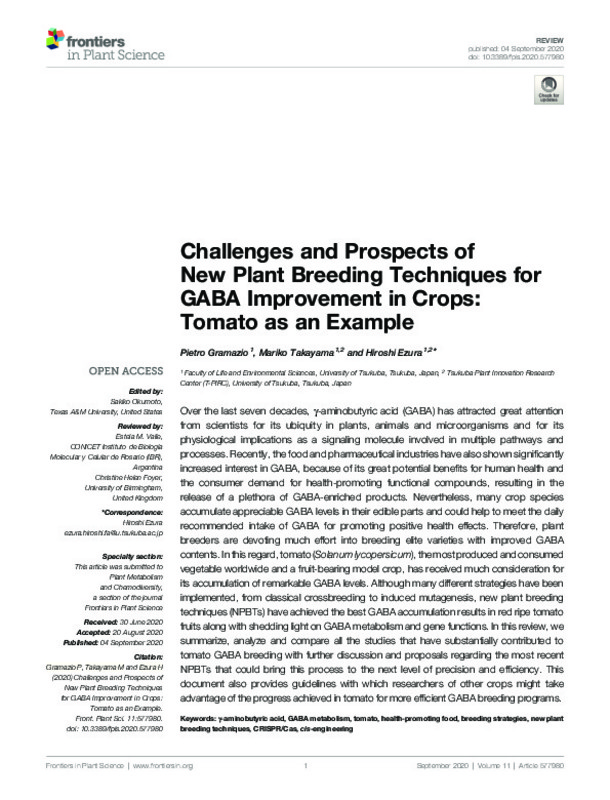JavaScript is disabled for your browser. Some features of this site may not work without it.
Buscar en RiuNet
Listar
Mi cuenta
Estadísticas
Ayuda RiuNet
Admin. UPV
Challenges and prospects of new plant breeding techniques for GABA improvement in crops: tomato as an example
Mostrar el registro sencillo del ítem
Ficheros en el ítem
| dc.contributor.author | Gramazio, Pietro
|
es_ES |
| dc.contributor.author | Takayama, Mariko
|
es_ES |
| dc.contributor.author | Ezura, Hiroshi
|
es_ES |
| dc.date.accessioned | 2022-05-10T18:06:40Z | |
| dc.date.available | 2022-05-10T18:06:40Z | |
| dc.date.issued | 2020-09-04 | es_ES |
| dc.identifier.uri | http://hdl.handle.net/10251/182478 | |
| dc.description.abstract | [EN] Over the last seven decades, gamma-aminobutyric acid (GABA) has attracted great attention from scientists for its ubiquity in plants, animals and microorganisms and for its physiological implications as a signaling molecule involved in multiple pathways and processes. Recently, the food and pharmaceutical industries have also shown significantly increased interest in GABA, because of its great potential benefits for human health and the consumer demand for health-promoting functional compounds, resulting in the release of a plethora of GABA-enriched products. Nevertheless, many crop species accumulate appreciable GABA levels in their edible parts and could help to meet the daily recommended intake of GABA for promoting positive health effects. Therefore, plant breeders are devoting much effort into breeding elite varieties with improved GABA contents. In this regard, tomato (Solanum lycopersicum), the most produced and consumed vegetable worldwide and a fruit-bearing model crop, has received much consideration for its accumulation of remarkable GABA levels. Although many different strategies have been implemented, from classical crossbreeding to induced mutagenesis, new plant breeding techniques (NPBTs) have achieved the best GABA accumulation results in red ripe tomato fruits along with shedding light on GABA metabolism and gene functions. In this review, we summarize, analyze and compare all the studies that have substantially contributed to tomato GABA breeding with further discussion and proposals regarding the most recent NPBTs that could bring this process to the next level of precision and efficiency. This document also provides guidelines with which researchers of other crops might take advantage of the progress achieved in tomato for more efficient GABA breeding programs | es_ES |
| dc.description.sponsorship | PG is grateful to the Japanese Society for the Promotion of Science for the JSPS postdoctoral grant FY2019-P19105 | es_ES |
| dc.language | Inglés | es_ES |
| dc.publisher | Frontiers Media SA | es_ES |
| dc.relation.ispartof | Frontiers in Plant Science | es_ES |
| dc.rights | Reconocimiento (by) | es_ES |
| dc.subject | Gamma-aminobutyric acid | es_ES |
| dc.subject | GABA metabolism | es_ES |
| dc.subject | Tomato | es_ES |
| dc.subject | Health-promoting food | es_ES |
| dc.subject | Breeding strategies | es_ES |
| dc.subject | New plant breeding techniques | es_ES |
| dc.subject | CRISPR/Cas | es_ES |
| dc.subject | Cis-engineering | es_ES |
| dc.subject.classification | GENETICA | es_ES |
| dc.title | Challenges and prospects of new plant breeding techniques for GABA improvement in crops: tomato as an example | es_ES |
| dc.type | Artículo | es_ES |
| dc.identifier.doi | 10.3389/fpls.2020.577980 | es_ES |
| dc.relation.projectID | info:eu-repo/grantAgreement/JSPS//FY2019-P19105/ | es_ES |
| dc.rights.accessRights | Abierto | es_ES |
| dc.contributor.affiliation | Universitat Politècnica de València. Instituto Universitario Mixto de Biología Molecular y Celular de Plantas - Institut Universitari Mixt de Biologia Molecular i Cel·lular de Plantes | es_ES |
| dc.description.bibliographicCitation | Gramazio, P.; Takayama, M.; Ezura, H. (2020). Challenges and prospects of new plant breeding techniques for GABA improvement in crops: tomato as an example. Frontiers in Plant Science. 11:1-16. https://doi.org/10.3389/fpls.2020.577980 | es_ES |
| dc.description.accrualMethod | S | es_ES |
| dc.relation.publisherversion | https://doi.org/10.3389/fpls.2020.577980 | es_ES |
| dc.description.upvformatpinicio | 1 | es_ES |
| dc.description.upvformatpfin | 16 | es_ES |
| dc.type.version | info:eu-repo/semantics/publishedVersion | es_ES |
| dc.description.volume | 11 | es_ES |
| dc.identifier.eissn | 1664-462X | es_ES |
| dc.identifier.pmid | 33014001 | es_ES |
| dc.identifier.pmcid | PMC7500313 | es_ES |
| dc.relation.pasarela | S\447639 | es_ES |
| dc.contributor.funder | Japan Society for the Promotion of Science | es_ES |








